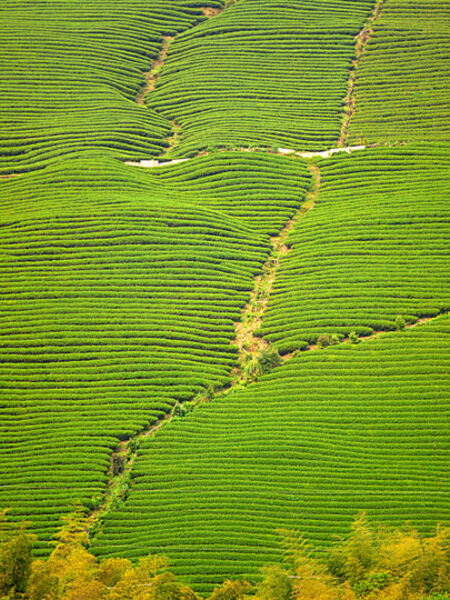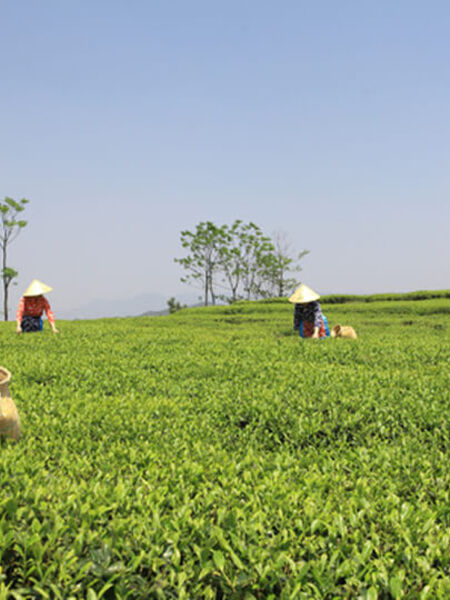The Anatomy of a Tea Bush


The Tea Bush, the source of all true teas. From bold black teas to mild and grassy green teas, to complex oolongs, before they’re turned into their colorful blends, all tea starts off as the leaves of a subtropical bush, Camellia sinensis (also known as the tea bush). As you delve further into the world of tea, picking up on the nuances of each cup, you inevitably develop an appreciation for the tea bush and all that it’s capable of. There’s more to the tea bush than meets the eye, so let’s discover more about the bush that gives us so much.
Camellia Sinensis: One Species, Two Variations
While everything that is classified as a true tea comes from one bush, there are two variations of that same bush that are used for tea production: sinensis and assamica. The Camellia sinensis var. sinensis is the variation used in China and is used mostly in green and white tea production as well as some oolong and black teas. If left unattended, the bushes can grow up to 15 feet, however the ones used for tea production are trimmed to waist length for easy harvest of its small, narrow leaves. These bushes thrive in the cool mountains of China and are harvested about five times a year before going dormant in winter.The Camellia sinensis var. assamica has big leaves and can grow even taller than it’s var. sinensis counterpart, up to 60 feet if left unattended. The bushes are harvested frequently all year long, about every 8 to 12 days. The preferred choice of tea bush in Northeast India, Sri Lanka, and Africa, this tea is also used (although less so) in the production of some Chinese teas and produces malty, strong black teas.
Parts of the Tea Bush
While every tea drinker knows about tea leaves, there are three main parts of the tea bush: the flowers, the fruit, and the leafset. While all three parts can be processed, the leafset is the most important to tea production.Flowers and Fruit
The tea bush produces small, white flowers that look similar to their relative, the camellia flowers found in gardens. The flowers bloom in the fall and allow the bushes to be pollinated. The flowers, like the leaves, can even be brewed into a tea. The tea bush also produces a small, hard, green and brown fruit that contains one to four seeds. It takes about a year for the fruit to develop and can be used to make tea seed oil which can be used for cooking (not to be confused with tea tree oil, a common ingredient in beauty products).
The Leafset
The most valuable part of the tea bush, the leafset is the leaves used in most tea production and is made up of the newly sprouted bud and the next two leaves after the bud. The reason why these leaves are so valuable is because they have the most nutrients, oils, and chlorophyll due to the bush devoting those resources to growing new leaves. Depending on where the bush is grown, the leaves can have varying thickness: the higher the altitude, the narrower the leaf, with smaller leaves tending to be the most sought-after.
The bud of the leafset is most used in the production of white tea. As the newest leaf on the branch, it is harvested when it has not yet unfurled. The bud has the most nutrients and the best flavor of the tea leaves. The next two leaves after the bud are ones that have been unfurled. While older leaves on the same branch can be used, but they are typically used in oolongs and black teas and not in the more delicate green and white teas.
Additionally, some teas are made with the twigs and stems from the tea bush. Though they are more inexpensive, they still produce excellent cups of tea. Some examples of these teas are Kukicha and Hojicha.
Tea Chemistry
Whether off the bush, dried, or brewed into a delightful beverage, tea is packed full of naturally occurring nutrients and chemicals interacting together in harmony. One of the often talked about characteristics of tea is its antioxidant content. Antioxidants help delay damage that can be caused by oxygen, such as premature aging and diseases like heart disease or cancer. Tea (specifically green and black tea) is packed full of antioxidants, most notably Flavonoids and Polyphenols, and studies have suggested that people who drink tea have less risk of heart disease and cancer. Tea also contains a polyphenol enzyme that causes oxidation in the leaves that if heated heated and destroyed, stops oxidation. This process is crucial to the production of green, white, and some oolongs, which must stop oxidation.
Caffeine is naturally occurring in the tea bush. With a moderate level of caffeine, tea’s caffeine level is known to help take the edge off fatigue, sharpen senses, and increase focus. While unbrewed tea leaves have a higher level of caffeine compared to the same amount of coffee grounds, brewing coffee extracts a higher amount of caffeine into the cup, meaning that a brewed cup of tea has less caffeine than a brewed cup of coffee.
Tea contains about twenty different amino acids, the most notable being L-theanine, which has been observed to help improve focus and performance as well as reduce stress. Tea bushes that have been shaded before harvest have more of this unique amino acid, meaning shaded teas (such as matcha and gyokuro) have a much higher level of L-theanine than other teas. In addition to amino acids, tea leaves also contain vitamins A, B, C, and K, though B and C are the only ones that make it into the brewed beverage. Minerals such as calcium, fluoride, magnesium, manganese, potassium, and zinc are also found in tea. Though enough of these vitamins and minerals is not found in a single cup of tea, it is still a source that, combined with other vitamin and mineral sources, can help you gain your daily requirements.
